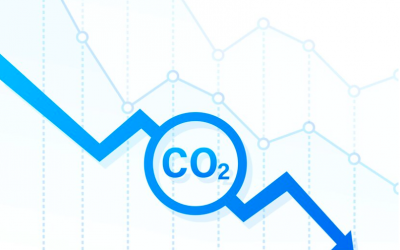Why do a carbon assessment?

The aim is to limit our impact on the environment, biodiversity and ecosystems that are sensitive to the rise in temperature we have been observing for several years. Although this target is only set for 2050, we need to act now if we are to achieve it. It is therefore important for everyone to act at their own level and with their own means.
Following this international agreement, a roadmap was published by the SNBC to help French public and private organizations participate in this collective effort.
To combat global warming, we need to reduce our greenhouse gas emissions. But before you can reduce them, you have to account for them properly and completely.
The carbon footprint is the tool used to quantifyan organization's carbon footprint. It quantifies all greenhouse gas (GHG) emissions generated directly or indirectly by an organization. Following an analysis of emission sources, it enables the implementation of an action plan and a carbon strategy to reduce emissions as much as possible. Finally, it proposes solutions for offsetting the emissions that are inevitably produced.
1.1. Being a committed company
2. Define an action plan to reduce GHG emissions
2.1. Reducing the impact of an organization's activities
An ecological approach
💪 Being a committed company
Green" companies are on the increase, and the desire to work with or for eco-responsible companies and products is growing. As a result, there is a growing demand for companies to carry out a greenhouse gas assessment to evaluate their impact on the environment and take action to help combat climate change.
Calculating an organization's carbon footprint on our environment therefore often starts with an intention to work in an eco-responsible way. Business leaders wishing to "do their bit" in the fight against climate change will choose to carry out a carbon footprint simply to understand how to reduce their impact on the environment.
The eco-gesture may not resonate with some people's aspirations and priorities, but there'smuch more to a carbon footprint than that! It can be carried out for economic reasons, or used as a sales argument.
⚖️ Regulations
The Carbon Footprint® is mandatory for :
- companies with more than 50 employees in France benefiting from the stimulus plan (Finance Act 2021, art. 244),
- for those with more than 500 employees, or 250 employees in overseas departments
- for local authorities with more than 50,000 inhabitants (Grenelle II law, July 12, 2010).
However, it remains a good commercial and eco-responsible argument for all other organizations. More and more companies are deciding to carry out their own carbon footprint, for a variety of reasons, over and above the regulatory Bilan GES.
🧠 So urce and methodology
The method used to account for GHG emissions must comply with ISO standards, in particular ISO 14064. The data required for this calculation comes from a variety of sources, such as energy bills, transport data, and so on.
The scope of emissions must be well defined, including both direct emissions (scope 1) and indirect emissions (scope 2 and 3). The transition to effective carbon accounting often involves association with specialist organizations such as ADEME. This requires accurate measurement of the carbon footprint in all aspects of organizational activity.
The march towards carbon neutrality requires a rigorous methodology to achieve the targets set in the fight against climate change.
Define an action plan to reduce GHG emissions
📉 Reducing the impact of an organization's activities
An action plan aimed at reducing the impact of the company's activities on all 3 scopes, by reducing its energy consumption for example, will inevitably result in substantial savings well in excess of the cost of the balance sheet.
From a communications point of view, producing such a report and distributing it internally within the company or externally to customers, partners or the authorities demonstrates a change in the company's eco-responsible stance. It will also raise awareness among the company's employees, making them full players in the company's move towards sustainability.
A strong commercial argument, this change of attitude can be put forward in calls for tender, for example.
🧑⚖️ Focus on a future carbon tax
Finally, a decisive point is the implementation of the future carbon tax in France. The carbon tax is an environmental tax on carbon dioxide emissions. The levy is direct and proportional to the quantities emitted, meaning that the higher the emissions, the higher the tax. Not yet in force, it will soon be applied to all sectors.
When the tax comes into force, all players will have to calculate their emissions in order to pay it. So, yes, we could say that we'll calculate our emissions when the tax comes into force. However, if you think about it, in order to reduce the cost as much as possible, you need to reduce your emissions as much as possible before the tax comes into force.
Carrying out an initial carbon assessment as soon as possible will enable you to implement reduction solutions and anticipate this future tax. Although there is a charge for carrying out a carbon audit, it represents a definite advantage for a company, organization or local authority.
It provides an economically and commercially interesting solution, but above all it allows us to participate in achieving the goal of carbon neutrality by 2050.
A greenhouse gas balance sheet is used to record an organization's emissions, and once this has been done, an analysis must be carried out. This analysis highlights the items that emit the most greenhouse gases, and identifies the areas where the organization needs to take action.
This analysis allows the implementation of an action plan to reduce emissions. This plan also allows to define the low-carbon strategy that the company wishes to follow and thus reach the objective of carbon neutrality by 2050 as requested by the government.
How do you perform your GHG assessment online?
Once you've convinced yourself that you need to carry out a GHG assessment, the question remains as to how and with whom to do it. Usually carried out using an Excel spreadsheet, a number of platforms have been developed to simplify the task of carrying out a carbon footprint. Global Climate Initiatives is one such platform.
GCI offers a platform that is adapted to each company's sector of activity, making it quick and easy to draw up a balance sheet. In addition to carrying out an assessment, the platform enables action plans to be defined, and helps companies to combat global warming by developing ever more advanced tools to meet users' expectations. You'll be able to account for, reduce and offset your emissions simply and effectively.
With the GCI platform, you can carry out your carbon assessment by business sector on your own or with the help of a carbon assessment expert. So, are you ready to carry out your carbon assessment?







